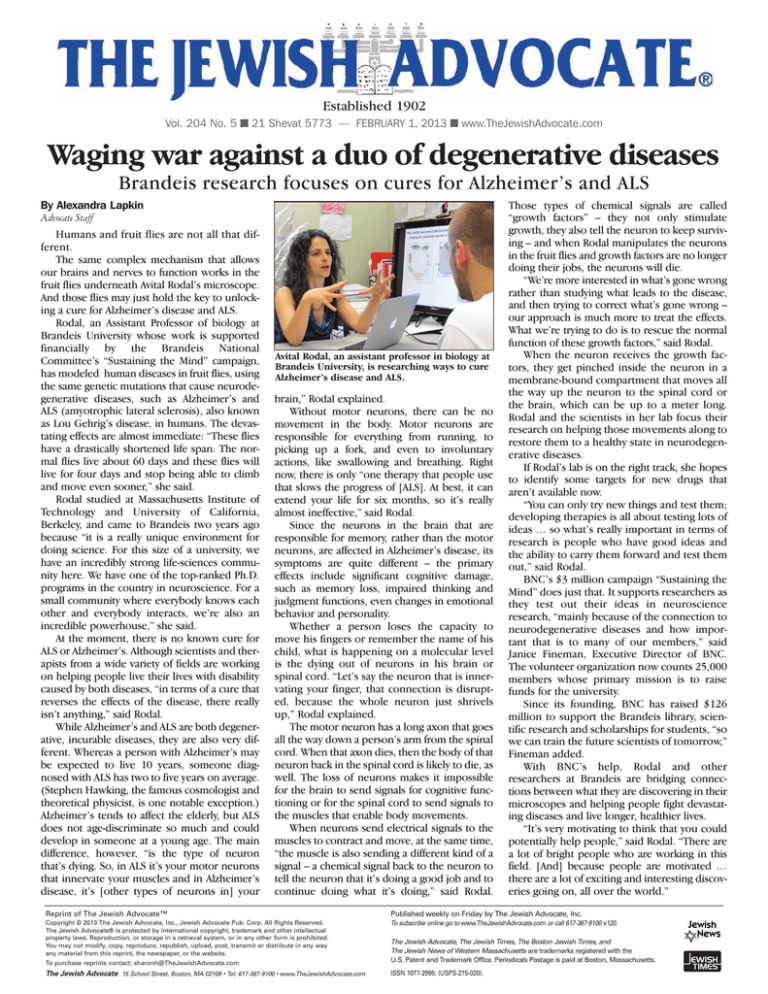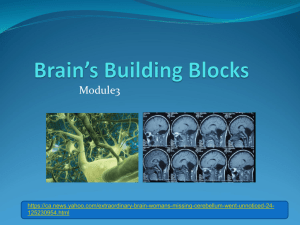
Established 1902
Established
1902
Vol.
204
No.
■ADAR
21 Shevat
— FEBRUARY
1, 2013
■ www.TheJewishAdvocate.com
Vol.
200
No.
95
I 3
57695773
— FEBRUARY
27, 2009
I www.TheJewishAdvocate.com
I $1.50
Waging war against a duo of degenerative diseases
Brandeis research focuses on cures for Alzheimer’s and ALS
By Alexandra Lapkin
Advocate Staff
Humans and fruit flies are not all that different.
The same complex mechanism that allows
our brains and nerves to function works in the
fruit flies underneath Avital Rodal’s microscope.
And those flies may just hold the key to unlocking a cure for Alzheimer’s disease and ALS.
Rodal, an Assistant Professor of biology at
Brandeis University whose work is supported
financially by the Brandeis National
Committee’s “Sustaining the Mind” campaign,
has modeled human diseases in fruit flies, using
the same genetic mutations that cause neurodegenerative diseases, such as Alzheimer’s and
ALS (amyotrophic lateral sclerosis), also known
as Lou Gehrig’s disease, in humans. The devastating effects are almost immediate: “These flies
have a drastically shortened life span. The normal flies live about 60 days and these flies will
live for four days and stop being able to climb
and move even sooner,” she said.
Rodal studied at Massachusetts Institute of
Technology and University of California,
Berkeley, and came to Brandeis two years ago
because “it is a really unique environment for
doing science. For this size of a university, we
have an incredibly strong life-sciences community here. We have one of the top-ranked Ph.D.
programs in the country in neuroscience. For a
small community where everybody knows each
other and everybody interacts, we’re also an
incredible powerhouse,” she said.
At the moment, there is no known cure for
ALS or Alzheimer’s. Although scientists and therapists from a wide variety of fields are working
on helping people live their lives with disability
caused by both diseases, “in terms of a cure that
reverses the effects of the disease, there really
isn’t anything,” said Rodal.
While Alzheimer’s and ALS are both degenerative, incurable diseases, they are also very different. Whereas a person with Alzheimer’s may
be expected to live 10 years, someone diagnosed with ALS has two to five years on average.
(Stephen Hawking, the famous cosmologist and
theoretical physicist, is one notable exception.)
Alzheimer’s tends to affect the elderly, but ALS
does not age-discriminate so much and could
develop in someone at a young age. The main
difference, however, “is the type of neuron
that’s dying. So, in ALS it’s your motor neurons
that innervate your muscles and in Alzheimer’s
disease, it’s [other types of neurons in] your
Avital Rodal, an assistant professor in biology at
Brandeis University, is researching ways to cure
Alzheimer’s disease and ALS.
brain,” Rodal explained.
Without motor neurons, there can be no
movement in the body. Motor neurons are
responsible for everything from running, to
picking up a fork, and even to involuntary
actions, like swallowing and breathing. Right
now, there is only “one therapy that people use
that slows the progress of [ALS]. At best, it can
extend your life for six months, so it’s really
almost ineffective,” said Rodal.
Since the neurons in the brain that are
responsible for memory, rather than the motor
neurons, are affected in Alzheimer’s disease, its
symptoms are quite different – the primary
effects include significant cognitive damage,
such as memory loss, impaired thinking and
judgment functions, even changes in emotional
behavior and personality.
Whether a person loses the capacity to
move his fingers or remember the name of his
child, what is happening on a molecular level
is the dying out of neurons in his brain or
spinal cord. “Let’s say the neuron that is innervating your finger, that connection is disrupted, because the whole neuron just shrivels
up,” Rodal explained.
The motor neuron has a long axon that goes
all the way down a person’s arm from the spinal
cord. When that axon dies, then the body of that
neuron back in the spinal cord is likely to die, as
well. The loss of neurons makes it impossible
for the brain to send signals for cognitive functioning or for the spinal cord to send signals to
the muscles that enable body movements.
When neurons send electrical signals to the
muscles to contract and move, at the same time,
“the muscle is also sending a different kind of a
signal – a chemical signal back to the neuron to
tell the neuron that it’s doing a good job and to
continue doing what it’s doing,” said Rodal.
Those types of chemical signals are called
“growth factors” – they not only stimulate
growth, they also tell the neuron to keep surviving – and when Rodal manipulates the neurons
in the fruit flies and growth factors are no longer
doing their jobs, the neurons will die.
“We’re more interested in what’s gone wrong
rather than studying what leads to the disease,
and then trying to correct what’s gone wrong –
our approach is much more to treat the effects.
What we’re trying to do is to rescue the normal
function of these growth factors,” said Rodal.
When the neuron receives the growth factors, they get pinched inside the neuron in a
membrane-bound compartment that moves all
the way up the neuron to the spinal cord or
the brain, which can be up to a meter long.
Rodal and the scientists in her lab focus their
research on helping those movements along to
restore them to a healthy state in neurodegenerative diseases.
If Rodal’s lab is on the right track, she hopes
to identify some targets for new drugs that
aren’t available now.
“You can only try new things and test them;
developing therapies is all about testing lots of
ideas … so what’s really important in terms of
research is people who have good ideas and
the ability to carry them forward and test them
out,” said Rodal.
BNC’s $3 million campaign “Sustaining the
Mind” does just that. It supports researchers as
they test out their ideas in neuroscience
research, “mainly because of the connection to
neurodegenerative diseases and how important that is to many of our members,” said
Janice Fineman, Executive Director of BNC.
The volunteer organization now counts 25,000
members whose primary mission is to raise
funds for the university.
Since its founding, BNC has raised $126
million to support the Brandeis library, scientific research and scholarships for students, “so
we can train the future scientists of tomorrow,”
Fineman added.
With BNC’s help, Rodal and other
researchers at Brandeis are bridging connections between what they are discovering in their
microscopes and helping people fight devastating diseases and live longer, healthier lives.
“It’s very motivating to think that you could
potentially help people,” said Rodal. “There are
a lot of bright people who are working in this
field. [And] because people are motivated …
there are a lot of exciting and interesting discoveries going on, all over the world.”
Reprint of The Jewish Advocate™
Published weekly on Friday by The Jewish Advocate, Inc.
Copyright © 2013 The Jewish Advocate, Inc., Jewish Advocate Pub. Corp. All Rights Reserved.
The Jewish Advocate® is protected by international copyright, trademark and other intellectual
property laws. Reproduction, or storage in a retrieval system, or in any other form is prohibited.
You may not modify, copy, reproduce, republish, upload, post, transmit or distribute in any way
any material from this reprint, the newspaper, or the website.
To subscribe online go to www.TheJewishAdvocate.com or call 617-367-9100 x120.
To purchase reprints contact: sharonh@TheJewishAdvocate.com
The Jewish Advocate, The Jewish Times, The Boston Jewish Times, and
The Jewish News of Western Massachusetts are trademarks registered with the
U.S. Patent and Trademark Office. Periodicals Postage is paid at Boston, Massachusetts.
The Jewish Advocate 15 School Street, Boston, MA 02108 • Tel: 617-367-9100 • www.TheJewishAdvocate.com
ISSN 1077-2995. (USPS-275-020).








